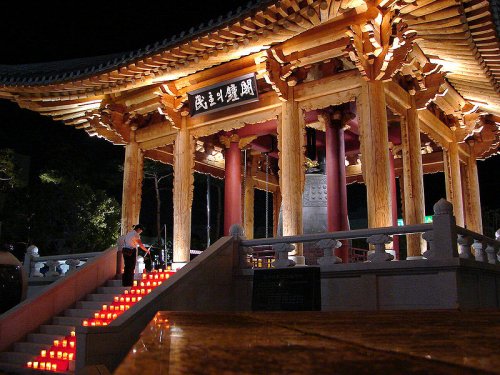 Gwangju is the 6th largest city in South Korea. It is a metropolitan city under direct control of the central government. The city is located on the southern part of the Korean peninsula. It has a population of 1.4 million people and an area of 501 sq km.
Gwangju is the 6th largest city in South Korea. It is a metropolitan city under direct control of the central government. The city is located on the southern part of the Korean peninsula. It has a population of 1.4 million people and an area of 501 sq km.Gwangju was founded in 57 BC and has acted as a regional political and economic centre. In modern times, however, the city only began to enjoy rapid economic development once the railroad was built to link it to Seoul. Among the industries that flourished in Gwangju include rice milling, breweries and textile manufacturing.
It was also in Gwangju that a civil demonstration took place in 1980 against the military government of Chun Doo-hwan, which resulted in the killing of hundreds by the military, including the firing of automatic weapons on unarmed demonstrators.
Travel to Gwangju
Most budget travelers arrive here by bus from Seoul. Alternatively, the KTX high-speed train covers the distance between Seoul and Gwangju in just 3 hours, and costs ₩39,000. There are also more economical local trains making the same journey for a longer time.Travel within Gwangju
The main forms of transportation in Gwangju are the buses and taxis. The city also has a single subway line, which is not the most practical, but quite cheap, at just ₩1,000 per ride to any location. Presently a second subway line is under construction, and will form a loop around the city center.Photos of Gwangju
 Gwangju Democracy Bell
Gwangju Democracy BellSource: https://commons.wikimedia.org/wiki/File:Korea-Gwangju_4890-06_Democracy_Bell.JPG
Author: Steve46814

Author: Steve46814

Places of Interest in Gwangju
- Gwangju National Museum
Museum housing treasures of the Chinese Yuan Dynasty that was recovered from a sunken ship. - Geumnamno and Chungmuro Streets
Pedestrianized streets in downtown Gwangju with much nightlife. - 5:18 Memorial Parks
Parks commemorating the Gwangju civilian massacre of 1980. - Mudeungsan Mountain
Mountain retreat for Gwangju residents. - Jeungsim-sa Temple
Buddhist temple on Mudeungsan. - Damyang
Center for bamboo cultivation near Gwangju. - Namwon
Ancient birthplace of Chunhyang, heroine of Korean literature.
 Latest updates on Penang Travel Tips
Latest updates on Penang Travel Tips
 Map of Roads in Penang
Map of Roads in Penang
Looking for information on Penang? Use this Map of Roads in Penang to zoom in on information about Penang, brought to you road by road.About this website

Dear visitor, thank you so much for reading this page. My name is Timothy Tye and my hobby is to find out about places, write about them and share the information with you on this website. I have been writing this site since 5 January 2003. Originally (from 2003 until 2009, the site was called AsiaExplorers. I changed the name to Penang Travel Tips in 2009, even though I describe more than just Penang but everywhere I go (I often need to tell people that "Penang Travel Tips" is not just information about Penang, but information written in Penang), especially places in Malaysia and Singapore, and in all the years since 2003, I have described over 20,000 places.
While I try my best to provide you information as accurate as I can get it to be, I do apologize for any errors and for outdated information which I am unaware. Nevertheless, I hope that what I have described here will be useful to you.
To get to know me better, do follow me on Facebook!
Copyright © 2003-2025 Timothy Tye. All Rights Reserved.

 Go Back
Go Back